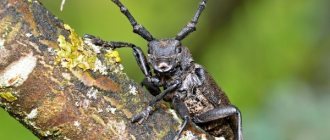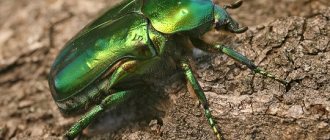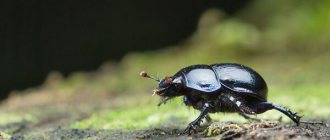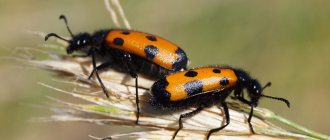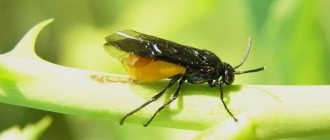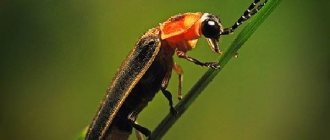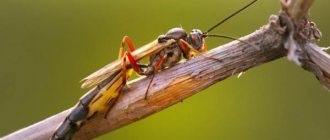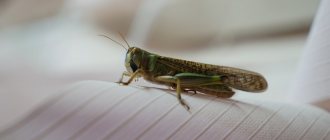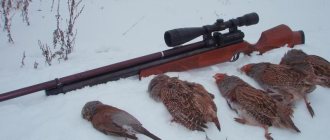Ecology
The titan lumberjack (Titanus giganteus) is the largest beetle and one of the most mysterious creatures on our planet.
Adults can grow up to 16.7 cm in length
and are distinguished
by very strong jaws
that can break a pencil in half. But, despite their impressive size and frightening bite, they are completely harmless to people.
The Titan Lumberjack lives deep in the hot tropical forests of South America and only emerges to find a mate.
.
Interestingly, no one has ever seen a larva
huge insect. However, scientists believe that they can reach 5 cm in diameter and 30 cm in length.
Judging by the large holes found in dead trees, the larva feeds on rotten wood for several years before reaching maturity. Male beetles do not feed as adults, but they do need energy to fly.
Who is the lumberjack titan
This is an insect that is the largest of all on the planet. Its length reaches 17 cm. The insect can be found in Brazil, Colombia, and Ecuador. Some travel companies specially arrange prices for trips to America for the purpose of catching a woodcutter. But the hunt is really justified; collectors are willing to pay from $650 to $1000 or even more for an insect. It all depends on the size of the titanium lumberjack itself. That is, if you transfer money to Russian rubles, it will be about 40 - 70 thousand.
The insect is most active at night. With the onset of dusk, they crawl out of those places where they are during the day - rotten stumps, snags, so tourists hunt for the titan woodcutter at night. But more often it is possible to catch males, since they are more sensitive to light.
The woodcutter titan can attack, but it never shows aggression first. Only if the insect is disturbed does it hiss and can even injure. Therefore, if you want to pick it up, you need to be extremely careful.
The lifespan of an adult is from 20 to 35 days. Compared to other beetles, this is small.
The transition from larva to pupa takes about 2 years. Morphology unknown. No larvae were found. It can be assumed that the size of the titanium woodcutter before pupation is about 24 - 36 cm. But scientists are only guessing at these data. Accordingly, the larvae are larger than the adults.
In this video you will find a lot of interesting things about the titanium beetle:
Read on topic:
Features of the life activity of ladybugs
14.11.2020
Description of chironomids and their possible danger to humans
14.11.2020
What do cutworms look like and what harm do they cause?
14.11.2020
What do goliath beetles look like and can they be bred at home?
14.11.2020
Lifestyle and habitat
The question: where does the woodcutter beetle live is not difficult to answer. It can take root in the world wherever there is wood and at least somewhat tolerable living conditions. Such beetles are bred in a variety of tree species, but they especially adore conifers. They can also live in shrubs and sometimes in herbaceous plants.
These pests are not only attracted to living trees. It’s a disaster if they appear in a person’s private home or at his dacha. Such insects are capable of causing irreparable damage to human buildings and, in fact, to everything made of wood.
They will destroy floorboards, furniture, wood upholstery, beams and partitions, attic beams and window frames. But these little pranksters do not pose any danger to the life and health of their owners, only to their property.
Lumberjack beetle larvae can cause damage to human property made of wood
The life activity of such insects directly depends on the factors surrounding them: the place where they live, as well as weather conditions, and most importantly, on the quality of the food that this or that species is inclined to eat.
Some of them risk leaving their shelters only under the cover of darkness. There are also types of beetles that love to feast on flower nectar. For this reason, they are usually active during the day. Some of the flying species show a penchant for long air travel.
In some species, this type of movement is more characteristic of females, while in others, on the contrary, only males are famous for flights.
What does a beetle look like?
In the photo of the titanium beetle you can see a long and slender body. The body of the insect is expanded, slightly flattened in the direction from the back to the peritoneum. When viewed from the side, the Lumberjack Titan looks like a lens. The body has a brown-brown color. But it can be black, blue-gray, white, green. On the upper part, some notice various patterns with stripes and spots. The head is positioned straight. On the first segment of the chest, there are 3 sharp spines on each side. The beetle has antennae in front of its eyes, which can be half the length of its body. The insect has 3 pairs of legs with sharp claws. The beetle has wings, which can sometimes come in handy. For example, some are born with the ability to fly.
A little bit of biology
Longhorned beetles have fairly small sizes (from one to several tens of millimeters), a flat body and mustaches, which are the main organ of smell. The color of lumberjacks is usually brown or dirty gray; less commonly, the longhorn beetle is black. The photo allows you to examine the insect in more detail.
The larvae of the pest are characterized by particularly powerful jaws, thanks to which they can handle both hard wood and soft metal with a cable-type coating. However, the beetles do not eat the latter so readily, preferring wooden structures and stacked boards.
https://youtube.com/watch?v=8yByw17C6NA%3Ffeature%3Doembed
The female barbel lays her eggs (from 200 to 400 pieces) in recesses or cracks in the tree, and after 7-14 days the larvae are born, which instantly activate the process of destroying the tree.
It is worth emphasizing that it is almost impossible to immediately notice a tree disease, since the larvae lead a hidden lifestyle. So, you can understand that your wooden house has succumbed to the harmful effects of longhorned beetles only when the real results of their work (destroyed and loosening wood) are visible.
What does it eat?
Throughout their lifespan, lumberjack titans live off their reserves. That is, adults do not eat. Life activity is carried out thanks to the reserves they made in the larval stage.
The titanium beetle is considered the most mysterious insect. No larvae have been found yet, but judging by the large holes in the trees, the food consists of rotten wood.
Faces can feed on rotten wood
Behavior
Lumberjack titans are found in almost all tropical forests of Latin America. The difficulty in detecting them is that adults (adults) live only about 3-5 weeks. Adults appear from December to March. During this period, they do not feed on anything and live off the reserves accumulated by the larva, leading a secretive nocturnal lifestyle.
Mandibles and spines are used only for self-defense.
During the day, beetles hide securely in tree hollows and rotten logs, and when darkness comes, they fly out of them to procreate.
What are the features of reproduction?
Beetles look for a partner for reproduction at night. With the onset of mating season, males fight with each other for the attention of females. During the battle, beetles can chew off body parts.
Females carefully look for places to lay eggs. Since the beetles feed only in the larval stage, they choose small wood cracks.
The number of eggs that 1 female can lay is enormous and reaches 400 pieces. The larvae appear after 1 – 2 weeks. Most often they are white. The larvae look like worms. But they are distinguished by their gluttony. The larvae have large, strong jaws that are used for more than just feeding. When all the food is eaten, they can make moves in the wood and move to another source.
What to do if you find a barbel at home
If a mustachioed pest is found in the house, then an emergency response is necessary. Why? It’s just that if this insect gets into wood, which is the main material of your home, then it will not calm down until it eats it or, as they say, if it doesn’t eat it, it will spoil it, causing significant damage to the building as a whole.
The longhorned beetle is not dangerous to humans, but it can harm him by destroying his home. To ensure that your home doesn’t care about insects, the wood should be treated during the construction stage. There are several ways to protect wood. Fumigation using phosphine gas is considered the most effective and optimal. This method of wood processing is held in high esteem by both owners of wooden buildings and carpenters, who process each unit individually.
A longhorned beetle visited your house and settled in it, a problem whose solution consists of the following actions:
, Assess the degree of damage to the material. To do this, you need to take a screwdriver and try to pierce the tree. If the tool enters easily, then it is impossible to do without eliminating a separate section of the surface of the house or the structure of the wood material (rafters, frames, beams). This is direct evidence that your house, or certain elements of it, is being eaten by a longhorned beetle. See photo of the damaged wooden beam below.
Hard wood can be left, but subjected to special treatment.
, Prepare the structure for the processing process. Clean the surface of the wood using a brush with increased rigidity. In this case, the person involved in this process must have special equipment: a respirator, glasses.
, Remove the dust layer with a vacuum cleaner.
, Cover the wooden surface with insecticide. Irrigate even surfaces, but intensively moisten holes and cracks with the product.
, Close all door and window openings in the room for several hours (usually 34 hours).
If the wooden surface is exposed, it must be systematically treated with hot drying oil. It is worth remembering that this option is far from the best, because when processed with such material, the original texture of the material is subject to change.
, Resort to the use of special products that penetrate deeply into the tree and are distinguished by a long period of preservation of their properties: “Antizhuk”, “Empire-20”, “Antishashelin”.
, Treat the tree with antiseptics once every 12 months. It is best to do this in the month of June.
, Treat affected areas of wood with carbon disulfide.
, Expose the affected tree to high temperatures (within 74 degrees). This can be done with a specially designed device, which will not be difficult to find and purchase.
What are some interesting facts?
There are various interesting facts about the insect:
- female titanium lumberjacks are larger than males;
- the name comes from the powerful jaws of the insect, with which the beetle is able to bite a branch with a diameter of 1 cm;
- males have longer antennae than females;
- Longhorn beetle larvae are considered a delicacy in the south, so it is possible that someone saw a titan woodcutter, but simply did not talk about it and ate it for lunch.
Males and females can be distinguished by the length of their whiskers
Prevention measures
Owners of wooden houses are recommended to carry out preventive measures once a year:
- wooden furniture, windows, doors should be wiped with a mixture of turpentine and paraffin (wax) and creolin 10:5:3. The paraffin should be melted first.
- it is important to maintain order in the house, clear food from tables, store spices and cereals in jars, monitor the temperature level, humidity,
- if the furniture is already damaged and not valuable, then it is better to throw it away immediately,
- before purchasing wood building materials, check for the presence of larvae,
- regularly check the house: walls, floors, windows,
- dry the bath using ventilation,
- treat wood with special antiseptics.
If bugs do appear in the house, then there is no need to panic. It is recommended to create an action plan and start following it. It is better, of course, to contact a special service for disinsection of the house. They have in their arsenal effective and proven means of pest control.
This solution will save you from a lot of problems and unnecessary worry. Also, some mixtures made at home or purchased in specialized stores dissipate only after 1 month or more, and are also harmful to health.
Only you can decide how to protect your home from unexpected guests!
What big beetles are there?
Large insects are listed in the table.
| Name | Description |
| Elephant | Lives in the tropics - America, Mexico, Venezuela. The length can reach from 7 to 12 cm. The beetle lives 1 – 3 months. |
| Actaeon | Carries out its activities in America. It grows up to 12 cm long. You can call this beetle American |
| Hercules | Has a large front jaw. It is a large beetle, so it is not much inferior to titanium in size. The length reaches 16 – 17 cm. It is found in Central and South America. |
| The insect has large horns, the length is measured along with them. They used to be jaws. So, the largest size is 17 cm. | |
| The difference between this species and titanium is that, on the contrary, the male is larger than the female. The female beetle is almost twice as large. | |
| Life expectancy – 6 months. The larvae mature in 2 years. | |
| The heaviest of all, since its weight can reach up to 100 g with a size of 13 cm | |
| Bigtooth | In other words, the Brazilian woodcutter or the stag-horned redtooth. The name is associated with the habitat. Life activities are carried out in Brazil. The second name is associated with the horn. |
| The length can reach 17 cm. With such a large size, beetles have the ability to fly. They are more active at night. | |
| The lifespan of an adult is a couple of months. But at the larval stage, the bigtooth can exist for up to 6 years. The difference is the color. The larvae are not white, like most, but brown | |
| Deer | Found in Europe and Asia. It is not dangerous to humans. It has a beautiful velvety brown-red color. The greatest length is 9.5 cm. But due to poor ecology, this figure is decreasing |
| Relic Lumberjack | It is found in the Russian Federation, namely in the Khabarovsk Territory and Primorye. The beetle is listed in the Red Book. Maximum size – 11 cm. Life expectancy – 4 months. But as a larva it can exist for up to 5 years. This is the only large beetle that is active during the day and not at night. |
| In appearance it does not differ in brightness of color. Has a brown color. Loves to feed on plant juices |
The Titan woodcutter beetle is one of the largest on the planet. Its lifespan is 25 – 35 days. Every tourist wants to see the woodcutter beetle, so they often go looking for it. Agencies raise prices for travel packages; collectors are willing to pay $600–$1,000 to catch the insect.
Notes
- Kryzhanovsky O. L., Mamaev B. M. Order Coleoptera, or Beetles (Coleoptera) // Animal Life. Volume 3. Arthropods: trilobites, chelicerates, trachea-breathers. Onychophora / ed. M. S. Gilyarova, F. N. Pravdina, ch. ed. V. E. Sokolov. — 2nd ed. - M.: Education, 1984. - P. 282. - 463 p.
- Catalog of Life: [https://www.catalogueoflife.org/col/browse/tree/id/7ca3293359de6c96012c60d54f706f0f Genus Titanus
] Retrieved July 06, 2016. - ↑ Yukio Yaznda & Shuji Okejima “Kafer der Welt”, 1990, 126 pages, 700 col illus
- Vanessa Hequet. Longicornes de Guyane. Cayenne, 1996
- Charles Leonard Hogue: Latin American Insects and Entomology. University of California Press, 1993 ISBN 0-520-07849-7 s. 280
- Mares J., Lapacek V. Nejkrasnejsi brouci tropu. Praha, 1980. 108 p.
- [https://ebay.com/ eBay - New & used electronics, cars, apparel, collectibles, sporting goods & more at low prices]
- [https://www.entomoservice.com/catalog/advanced_search_result.php?keywords=Titanus+giganteus+&x=10&y=10 entomoservice.com]
Folk methods of struggle
Based on folk recipes, it is possible to prepare effective means of combating woodcutter beetles. For example:
- Take a 2.5% solution of sodium fluoride (250 g) and dilute it in 10 liters of water. Wooden structures are treated using a spray bottle, using 200 ml of product per 1 square meter.
- The product is prepared from identical parts of resin, black carbolic acid and naphthalene. The product is applied to the wood using a brush.
- It is permissible to treat wooden furniture with hot drying oil, but this method will deprive it of its attractiveness.
- Kerosene and turpentine are mixed in a ratio of 1:3. The tree is treated with Vaseline, and the prepared liquid is poured into the beetle passages. After this, the entrances are sealed with paraffin.
Pest control methods
Bighead trout are an exceptionally resilient species and are difficult to control.
Pesticides are not very effective due to the fact that the beetle hides deep underground, and insects have to be collected by hand.
To prevent the beetles from getting into the garden, since they cannot fly, a groove about 30 cm deep is dug along the perimeter of the plot. It is good to put greens treated with pyrethroid preparations at the bottom of the groove. Pyrethroids are good because they are harmless to humans
and pets, they only act on insects. You should inspect the ditch from time to time and destroy the beetles that get there. But you still need to constantly manually collect beetles that have settled on the site. It is also useful to loosen the ground, filling the entrance to the beetles' burrows.
Another interesting folk remedy for combating crabgrass is ordinary sunflower oil. They take the cheapest oil, dilute it with water and, after shaking, pour this mixture into the mink. The beetles crawl out of their holes and are destroyed. You can also spray the edge strips and places where the pest has settled with a solution of sunflower oil (a glass per 10 liters of water).
It makes sense to use soil insecticides during insect reproduction, when apple trees are blooming. You can try spraying insect holes, seedlings, saplings, and seedlings with the following preparations:
- "Arrivo"
- "Diazinon"
- "Decis".
To prevent the migration of insects from the fields, it is worth trying to use “Karate” (five percent solution). Spray only a narrow strip of land along the border of the summer cottage. But still, trenching and sunflower oil are the most effective in this battle between a person and a tenacious insect. And be sure to be extremely careful when using insecticides: firstly, most insecticides are by no means harmless to humans, and secondly, they will also kill beneficial pollinating insects.
Good luck in your fight against the kravchiki!
